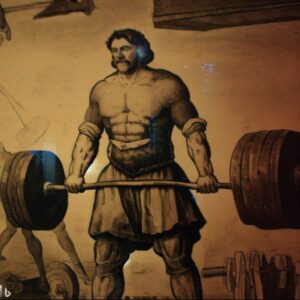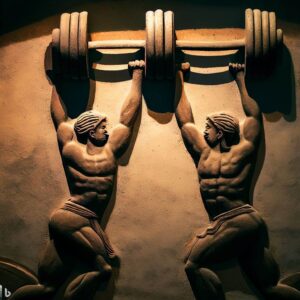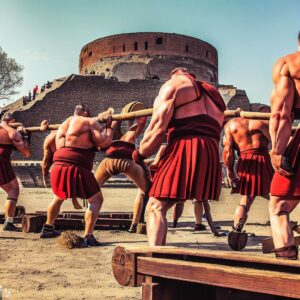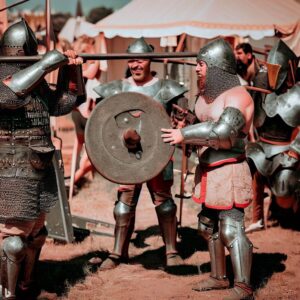
The history of free weights and their impact on fitness is an epic journey, spanning from the Stone Age to the modern day. Over centuries, these strength-building tools have developed in sophistication and purpose, allowing individuals to build muscle mass efficiently while providing numerous health benefits. In this article, we will explore how free weights have evolved throughout time as well as their role in shaping physical culture today.
From primitive stone discs used by ancient Greeks to the wide array of iron pumps now available on the market, free weights have been a mainstay in physical training for many generations. It was not until recent years that the importance of weightlifting began to be fully appreciated – both for its aesthetic effects and its ability to improve overall health. Whether it’s for competition or simply personal improvement, weightlifting exercises are now commonplace among athletes and laypeople alike.
As we delve into this story of progress and development, let us recall the wisdom of past trainers who strived to optimize human performance through bodyweight exercises: “To strive with all one’s might towards perfection…to seek out every means at one’s disposal.” With such words in mind, we can better appreciate why free weights remain so popular even in our digital age – they offer an effective way to train our bodies safely and effectively.
The Roots Of Free Weight Training – Ancient Civilizations And Their Fitness Regimes

It is estimated that, in the modern day, free weight training is practiced by over half of all gym-goers. This indicates a long history and evolution of the use of weights in fitness regimes across ancient civilizations. Halteres were one of the earliest forms of free weights used, originating in Ancient Greece between 776 to 480 BC. These halteres were made from stone or metal such as lead or iron and were typically held in both hands while being moved up and down during exercise. Greek influence can be seen throughout many aspects of modern strength training techniques, having been adopted into physical culture practices around Europe during the 19th century renaissance period. Roman strongmen also utilized various weighted implements for conditioning purposes with evidence found even before 100BC.
Free weightlifting has been embedded into human society since antiquity; its roots stretch back to ancient civilizations who developed different methods to build strength and endurance through their own tailored fitness regimes. In Egypt for instance, archaeological discoveries suggest that manual labor was largely responsible for creating an early form of resistance training. During medieval times knights would perform extensive bodyweight exercises including running, jumping, throwing rocks, swimming and lifting logs which formed part of their core training program leading up to battle. All this demonstrates how people have sought ways to increase physical prowess since time immemorial – often relying on primitive tools such as stones or logs if no other equipment was available at the time.
From these humble beginnings arose today’s sophisticated range of fitness programs incorporating advanced variations on traditional movements using a variety of weight formats such as dumbbells, kettlebells and barbells – all offshoots from those initial attempts by our ancestors centuries ago to become stronger, faster and more capable physically than ever before.
The Greek Influence – Halteres And The Birth Of Resistance Training
The Greeks have long been revered as a people who placed great emphasis on physical activity and exercise. Resistance training, or the use of external weight to develop strength, was an integral part of their fitness regimes. One of the earliest and most popular forms of resistance training in ancient Greece were halteres – handheld stone weights used for various exercises such as throwing activities and bodyweight squats.
Halteres had a significant impact on Greek fitness culture and ushered in a new era of resistance-based training methods. This style of training allowed individuals to increase their overall muscle mass, improve athletic performance, reduce injury risk, and become more physically capable than ever before.
Halteres also served additional purposes beyond just providing resistance; they acted as markers that enabled athletes to track progress over time by measuring how much weight could be lifted each session. The primary benefit of using halteres was that it allowed individuals to train with heavier loads than is typically possible during bodyweight workouts alone. With this newfound ability came even greater potential for progression: users could continually add more weight while maintaining good form and avoiding injury.
- Benefits
- Increased Muscle Mass
- Improved Athletic Performance
- Reduced Injury Risk
- Additional Purposes
- Markers to Track Progress Over Time
- Enables Training with Heavier Loads * Increased Strength and Endurance
Roman Strongmen – Building Muscles for The Empire

The Romans were renowned for their strength and power; an empire that stretched from Britain to North Africa. They believed in the value of physical fitness, and it was evident throughout their culture. In order to maintain their dominance, Roman strongmen developed a variety of weight training regimes which enabled them to build muscle faster than ever before.
Roman soldiers used the same techniques as modern bodybuilders: they lifted stones and logs, performed exercises with wooden clubs, curled dumbbells and hoisted heavy objects into the air. The aim was not only to increase muscularity but also to improve endurance, balance and agility. This type of physical conditioning was part of everyday life for many powerful members of society – politicians, gladiators, athletes and even slaves who were forced to take part in combative shows or battles.
Weightlifting soon became popular among civilians too; people wanted to acquire the strength that came with such workouts. As time passed by, these routines evolved further still – barbells replaced stone weights, gymnasiums opened up around cities and specialist trainers began teaching people how to get fit using free weights. It is clear then that the importance placed on physical fitness had its roots deep within ancient Rome’s illustrious history – one that has had a lasting influence on our current approaches towards health and wellbeing today.
The Middle Ages – Fitness for Knights and Nobles

The Middle Ages saw a shift in the focus of fitness from the rural and hunter-gatherer societies to those of nobles and knights. During this period, strength training was seen as an important part of physical culture for members of noble society, who used it to prepare themselves for battle or jousting tournaments. This form of exercise was also used by some commoners, though usually not on the same scale as that practiced by the nobility. The muscle-building exercises employed in this era included weightlifting with stones and rudimentary dumbbells made out of wood or metal bars filled with sand or other materials.
These tools allowed individuals to gain greater control over their body movements through increased muscular coordination and endurance, which could then be applied during activities such as swordplay or archery practice. Strength training also served an aesthetic purpose; many people desired well-developed musculature throughout history, even before modern ideas about beauty developed. Such practices still existed in more traditional forms until they were supplanted by professionalized competitive sports like boxing and wrestling in later centuries.
The concept of physical culture evolved significantly during the Middle Ages, both among royalty and within everyday life. Muscular development came to be associated not only with warriors but also with status symbols for aristocracy across Europe – due largely to its established role in military training – making strength training central to achieving social recognition at the time.
The Renaissance and The Revival Of Physical Culture
The Renaissance period opened up a new world of fitness for the privileged few. The upper classes were no longer content with simply being able to survive in physical terms – now they wanted to excel and be stronger than their peers. It was during this time that physical culture as we know it today began to emerge, with strength sports such as wrestling, weightlifting, gymnastics, fencing and jousting becoming popular activities amongst the aristocracy.
Leaders of physical activity during this period included Italian teachers like Girolamo Mercuriale and Cesare Lombroso who were advocates for functional training methods which focused on improving everyday performance rather than pure aesthetics. This shift towards practicality meant more emphasis was placed on exercises that would help improve mobility and agility instead of just brute strength or size alone.
At the same time these revival training techniques started to gain traction throughout Europe, newly developed equipment such as dumbbells, spring-loaded bars and kettlebells also made an appearance. These tools enabled people from all social backgrounds to engage in strength sport activities regardless of access to wealth or resources; thus allowing individuals from every level of society to benefit from improved physical health through regular exercise.
The Industrial Revolution – Iron And Steel Transform Weight Training
The Industrial Revolution saw a significant transformation in the construction of weight training equipment. The introduction of iron pumps and steel weights allowed for more efficient production techniques and enabled greater durability, increasing their use in strength training. As industrialization began to spread across Europe, iron pumps became increasingly popular as an exercise option due to their affordability and availability.
Steel weights were also becoming commonplace during the era with numerous fitness centers being established throughout Europe offering new advancements in weightlifting technology. Steel weights could be customized to suit individual needs, allowing users to increase or decrease load depending on preference. This revolutionized how people trained and created a much larger market for gym equipment manufacturers.
The combination of these two innovations changed the landscape of weight training forever; providing people with access to quality workout equipment at affordable prices. It opened up possibilities for athletes all over the world who wanted to improve their performance using resistance exercises that had not been possible before this period in history. Weight training was no longer limited by cost or accessibility but rather by one’s determination and dedication to achieve physical goals – opening many doors for those seeking personal advancement through physical fitness.
Pioneers Of Modern Weightlifting – Paving The Way For Strength Sports
Pioneers of modern weightlifting have paved the way for strength sports, revolutionizing barbell training over time. Beginning with the development of Olympic Weightlifting in 1896, physical culture has advanced from rudimentary stone age tools to sophisticated gym machines and equipment. The early days saw a push towards improving one’s physical abilities through exercise rather than using drugs or surgery as was commonplace earlier.
The 19th century ushered in many fitness pioneers who sought to develop strength-building exercises such as weightlifting and bodybuilding. One such figure is Eugen Sandow, known as “the father of modern bodybuilding” who helped popularize physical training around the world by holding demonstrations at public events and exhibitions. His influence had a profound effect on what would later become the field of strength sports.
Another important contributor was German doctor and strongman Dr. Hermann Goerner, whose amazing feats of strength gained him worldwide recognition during his lifetime including being featured in Ripley’s Believe It Or Not!. He made it his mission to promote health and wellness through strength training which ultimately led to an increase in popularity for lifting weights among athletes looking for improved performance. As more people began to engage in these activities, organized competitions were held allowing participants to test their skills against each other while also establishing standards for judging performances. Today, competitive weightlifting continues to be popular at both amateur and professional levels thanks largely due to the efforts of these pioneering individuals who opened up a new path into fitness that still stands today.
The Golden Age Of Bodybuilding – Muscular Icons And Free Weights
The Golden Age of Bodybuilding saw the emergence of some of the most iconic figures in fitness history. It was a period that revolutionized strength sports and brought free weights to the forefront of muscular development goals. This era featured numerous bodybuilding icons, such as Joe Weider, Arnold Schwarzenegger, and Lou Ferrigno. They embodied an aesthetic ideal through their use of free weights for maximizing muscle growth and definition; this created immense popularity in terms of both commercial success and public recognition.
This time also marked a shift from traditional weightlifting techniques to modern methods using barbells, dumbbells, machines, and other equipment designed specifically for building muscle mass. These tools allowed athletes to achieve better results with less risk than ever before. In addition, new training philosophies emerged during this period which focused on progressive overload principles to maximize gains without injury or plateaus in performance.
During The Golden Age of Bodybuilding, individuals could gain access to professional-level resources previously unavailable to amateurs due largely in part to the increased availability of free weights at home gyms around the world. This paved the way for larger numbers of people interested in pursuing physical feats beyond what were once considered impossible – all thanks to these strongmen pioneers who helped shape our current understanding of strength training.
The 21st Century – A New Era Of Functional Training And Innovation
The 21st century is a period of unprecedented advancement in the fitness industry. With the emergence of functional training, strength sports, and muscular icons, this era has seen an unparalleled wave of innovation that has altered how people approach physical health and performance.
Functional Training: Functional training focuses on improving balance, coordination, power, agility and overall body control for everyday activities. It combines traditional resistance exercises with dynamic movements to strengthen tendons and ligaments as well as muscles. Popular exercises include squat jumps, burpees, medicine ball slams and push-ups on stability balls. Common pieces of equipment used are battle ropes, kettlebells, sandbags and TRX bands.
Strength Sports: Strength sports have come into the spotlight in the last decade with more athletes taking part in competitions such as weightlifting (Olympic style), strongman events (farmers carry/deadlift medley) and power lifting (bench press). The rise of professional strongmen such as Hafthor Bjornsson ‘Thor’ from Iceland has also helped increase awareness around these disciplines.
| Type | Examples | Equipment |
| Functional Training | Squat Jumps – Burpees – Medicine Ball Slams | Battle Ropes – Kettlebells – Sandbags – TRX Bands |
| Strength Sports | Weightlifting (Olympic Style) – Strongman Events (Farmers Carry/Deadlift Medley) – Power Lifting (Bench Press) | Barbells – Dumbbells – Plates – Platforms |
Muscular Icons: Social media platforms have enabled aspiring lifters to showcase their progress which led to the formation of online communities dedicated to building muscle mass where users can share tips and advice about workout routines or nutrition plans. This resulted in many muscular icons becoming prominent figures within contemporary culture such as Jeff Cavaliere (athleanx), Steve Cook (bodybuilding.com), Lazar Angelov(lazar_angelov_official) etc… who have millions of followers across different channels including YouTube & Instagram .
This new era has provided opportunities for individuals all over the world to access modern methods of exercise while gaining knowledge through digital resources which was not available before due to geographical limitations or financial restrictions making it easier than ever before to get fit & stay healthy.
The Future Of Free Weight Training – Exploring New Horizons
The 21st century has seen a tremendous shift in the world of free weights and their impact on fitness. The rise of functional training and innovative approaches to strength sports have revolutionized how individuals approach weightlifting, challenging traditional methods with new ideas that are more effective and safer than ever before. However, this is just the beginning of what could be an incredible journey for free weights into the future.
With advances in technology and research, it is possible that we will see even greater strides forward in terms of:
- Improved safety protocols for athletes using free weights.
- Greater knowledge about the human body’s response to different types of exercises.
- More athletic-specific programs are designed to maximize performance gains.
- Better understanding how nutrition influences muscle growth and development.
- Groundbreaking innovation to explore unknown horizons within strength sports.
Free weight training trends continue to evolve as our collective knowledge grows. With each passing day, a new horizon opens up – one full of potential opportunities for discovering groundbreaking techniques, gaining insight into optimal exercise regimens, and uncovering hidden secrets behind muscular development. As such, exploring these possibilities won’t only benefit current generations but those who come after us too. This means pushing further towards the boundaries of what is possible while also staying committed to preserving history through documented evidence so that future generations can reap its rewards too.
Conclusion
This journey through history has revealed the enduring appeal of free weights and their impact on physical fitness. From ancient civilizations to modern innovators, there is no denying that these tools remain central to our understanding of strength training. In the past, they were used as part of an individual’s journey towards muscularity and performance; today, however, they are embraced for their ability to develop functional movement patterns and overall athleticism.
As this epic tale continues into the 21st century, it is clear that free weights will continue to play a major role in physical culture. With new trends such as CrossFit and weightlifting continuing to gain popularity, people have begun to explore ever more innovative ways of incorporating them into their workouts. Whether being used for building muscle or developing coordination skills, free weights offer something unique for every athlete.
From primitive stone discs to barbells with advanced technology – from warriors of old to modern-day fitness fanatics – we can see how far we’ve come since the dawn of human civilization. The influence of free weights resonates throughout human history, allowing us to appreciate both its achievements so far and what possibilities may lie ahead for its future development.